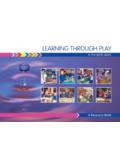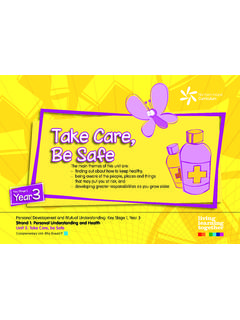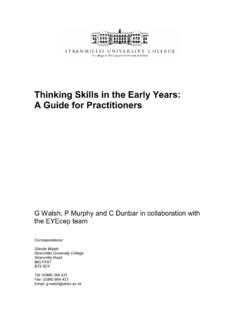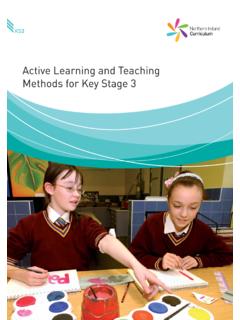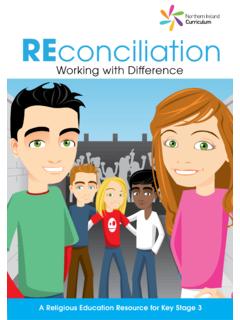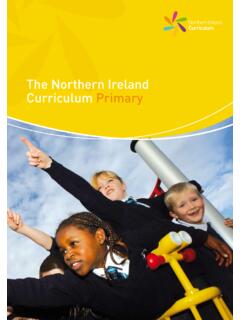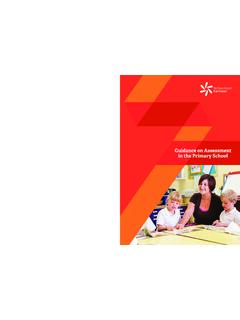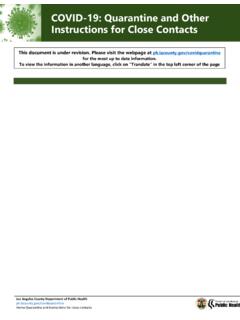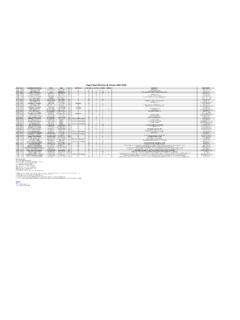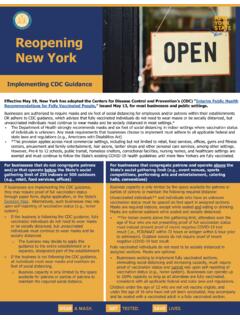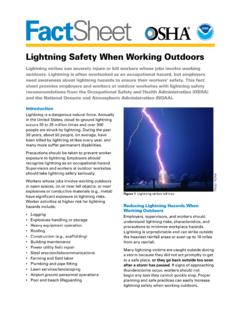Transcription of (PDF) Foundation Stage, Learning Outdoors
1 Learning OUTDOORSA Resource Bookin the early yearsLEARNING Outdoors INTRODUCTIONin the early yearsLEARNING Outdoors INTRODUCTION2 CONTENTSINTRODUCTION4 SECTION 1 RATIONALE & PRINCIPLES7 SECTION 2 PURPOSE13 SECTION 3 AREAS OF LEARNING17 Imaginative Area Creative Area (Art/Design & Music) Snack Area Horticulture Areas(Gardening/Wild and Digging) Large-Scale Construction Area Sand and Water Areas Quiet Area Large-Movement Area Small-Equipment Area Climbing Area Wheeled Vehicle Area Storage Suggestions Play Resource Centres Northern IrelandSECTION 4 AREAS OF PLAY Learning BAYS33 The Arts Language and Literacy Mathematics and Numeracy Personal, Social and Emotional Physical Development and Movement The World Around UsLEARNING Outdoors INTRODUCTION3 SECTION 5 SUGGESTED GUIDANCE FOR PLANNING81 SECTION 6 ROLE OF THE ADULT129 SECTION 7 outdoor PLAY BOXES/BAGS149 SECTION 8 SUGGESTED BOOKS, RHYMES & SONGS 159 SECTION 9 FOREST SCHOOL167 Audit Playground Design Safety & Risk Assessment Planning for Learning Adult Interaction Developing An outdoor Play Policy Suggested Books.
2 Rhymes & Music Adults Reading List WebsitesLEARNING Outdoors INTRODUCTION4 This resource has been compiled by members of the Early Years Interboard Panel in response to requests by practitionersin Early Years settings for guidelines on provision and progression in Learning methodology and suggested progression in this document is appropriate for pre-school and proposed FoundationStage as recommended by is proposed that teachers will use this resource as a starting point for their own hope you find it BrattonUna CrosseyDawn CrosbyWendy McKeownLEARNING Outdoors INTRODUCTION5 ACKNOWLEDGEMENTST hank you to those Early Years settings and schools who contributed the inspiring photographs used throughout you to Mairead O Boyle (NEELB Early Years Administration) for her endless patience and her word-processing , a special word of thanks to The Early Years Interboard Panel and colleagues for their NSSt Teresa's NSEdenderry NSNEELBS teeple NSKylemore NSMossley NSBuick Memorial NUSt Columba s NU, KilreaSt Columba s PS,DraperstownNew Row PSSELBThe Grove NSDromore NSAnnalong NSKilkeel NSSEELBFort Hill PSKillowen NUHoly Trinity NSSt Mary s PS, ArdglassSt Malachy s PS, BangorPond Park NSSt Therese NSWELBB allykelly PSLimavady NSGalliagh NSLisnagelvin NSLisnagelvin PSGrove NU Barrack St Boys,StrabaneBelmont NSSteelstown NURATIONALE AND PRINCIPLESin the early yearsSECTION 1 SECTION 1 RATIONALE AND PRINCIPLES9 RATIONALEThe outdoor area provides young children withone of the best possible environments in whichto learn.
3 Any adult who has watched childrenplaying in a well planned and well resourcedoutdoor area with involved adults will haveobserved the joy and excitement theyexperience as they learn new skills and makefresh discoveries. the best kept classroom and the richestcupboard are roofed only by the sky Margaret McMillan (c1925)Nursery Schools and the Pre-school Child NSA PublicationSECTION 1 RATIONALE AND PRINCIPLES10 The garden was arranged on different levels, on grass and hard surfaces. There were paths,steps, logs, trees, shrubs, ponds, seats, tables, slides, ropes, swings, playhouses, planks,ladders, barrels and was a kitchen garden, a wild garden and a rock garden. There was a plethora of naturalmaterials twigs, leaves, stones, bark, seeds and so on. The moveable equipment includedtrucks, wheelbarrows and bicycles. Children used real tools. Sand, water and builders brickswere available. Children had access to dressing up materials. The garden naturally attractedbirds and they were further encouraged with bird boxes, bird baths and bird tables.
4 Animals,including chickens, tortoises, rabbits and fish were kept. Children had access to scientificequipment and small games apparatus. Margaret McMillan s Open Air Nursery School, Deptford 1 RATIONALE AND PRINCIPLES11 outdoor PLAY PRINCIPLES Indoors and Outdoors need to be viewed as onecombined and integrated environment. Indoors and Outdoors need to be available to thechildren simultaneously. Outdoors is an equal player to indoors and shouldreceive planning, management, evaluation, resourcing,staffing and adult interaction on a par with indoors. Outdoors is both a teaching and Learning environment. outdoor design and layout needs careful consideration. outdoor play is central to young children s Learning ,possibly more to some children than others. The outdoor classroom offers children the opportunity toutilise effective modes of Learning play, movementand sensory experience. Children need versatile equipment and environments. Children need to be able to control, change and modifytheir environment.
5 Staff have to be supportive toward outdoor of outdoor Play in the Early Years Helen BiltonThese principles underpin the Early Years planned and well resourced outdoor play experiencesallow for progression in a child s thinking andunderstanding. These can provide the context in which theseprinciples become the reality for all our the early yearsSECTION 2 SECTION 2 PURPOSE15 It allows and encourages children to relivetheir experiences through their most naturalchannel movement. Movement is one of the four vehiclesthrough which children can learn. Theothers are play, talk and sensoryexperiences. It provides access to space to nurture mind-body growth. Physical development is the pre-requisite forthe children s growth. It: enhances the development of motor skills(gross and fine); develops co-ordination, balance and bodyawareness; keeps the body, heart and other organshealthy; and develops a life-long good habit of DEVELOP outdoor PLAY?
6 SECTION2 PURPOSE16 It provides the opportunity for assessed riskyfreedom, where children can play and socialisefreely and use their own imagination andinitiative. All the areas of Learning can be achievedoutside while the children s long-term social,emotional and mental health are beingenhanced. Exercise can affect emotions allowing forrelaxation and calmness and a heightenedsense of well being (Armstrong 1996).Young children s basic need for well-being andinvolvement, and their urge to explore and makesense of the world, is developed through high-quality play in an outdoor OF LEARNINGin the early yearsSECTION 3 The ArtsLanguage and LiteracyMathematics and NumeracyPersonal, Social and EmotionalPhysical Development and MovementThe World Around UsSECTION3 AREASOFLEARNING19 Art and DesignChildren will have opportunities to: explore a variety of materials and appreciatecolour, shape, texture and sound at verticaland horizontal levels; experienceavarietyofmediaandtechniques such as painting, drawing, markmaking, modelling and printing, both largeand small scale; develop their sense of spatial awarenessthrough the use of 3D and other materials,eg working with recyclable materials toshape, rearrange and create environmentssupporting imaginative play.
7 And observeandexperienceoutdoorcharacteristi cs using all of their ARTSSECTION 3 AREAS OF LEARNING20 MusicChildren will have opportunities to: listen and respond to a variety of sounds,rhythms and songs in the outdoorenvironment; make music by vocal sounds, bodysounds, singing, clapping and playingpercussion instruments with extendedvolume; make and use instruments to invent musicwhich expresses thoughts and feelings; participate in simple dances and singinggames; listen to and recognise sounds in theoutdoor environment; and use outdoor features as a stimulus AREASOFLEARNING21 Drama/Imaginative PlayChildren will have opportunities to: plan, design and engage in stimulating role play, which encourages them to play co-operatively,negotiate roles, agree rules and act out scenarios; express their thoughts, ideas, feelings and imagination with confidence, enhancing self-esteemand oral language; link imaginative play scenes inside and out, providing much more scope for large movement,noisy play and involving the whole child; and access a wide range of equipment, resources and props to promote quality outdoor 3 AREAS OF LEARNING22 LANGUAGE AND LITERACYT alking and ListeningChildren will have opportunities to: talk about their experiences in the outdoorenvironment; talk about features of the outdoor environment; use language to describe, explain, predict, andask questions; interact and converse with adults and peers toextend language; develop ideas and follow directions andinstructions; listen, respond and link language with physicalmovement in action songs and rhymes, role playand practical experiences; and talk, listen and interact with each other in allareas, including a quiet AREASOFLEARNING23 ReadingChildren will have opportunities to: access a wide range of texts books, leaflets, catalogues, reference materials,magazines, posters, maps, charts.
8 Enjoy stories, rhyme and songs in the outdoor environment; and experience a variety of meaningful print (eg labels, symbols, signs, anddirections), and begin to understand some purposes for 3 AREAS OF LEARNING24 WritingChildren will have opportunities to: experiment with early writing using water and rollers,brushes, chalk, sand and paint, clipboards andpencils; use their drawings, written marks or writing toexpress their ideas and feelings; see themselves and adults using writing for apurpose, and discuss and agree the best way topresent the writing, eg lists, messages and reminders;and write during role play and other will have opportunities to: sort and categorise resources, equipment and naturallyoccurring objects; identify, understand and use numbers both cardinaland ordinal, eg numbers on parking bays, numberlines, number plates, counting games, rhymes, jinglesand stories; develop appropriate mathematical language throughcounting games, rhymes, jingles and stories; recognise, explore and create patterns, shapes andcolours, eg with leaves, pebbles and 2D shapes; match objects, eg match photographs with outdoorfeatures; compare size, length, capacity and weight, eg playingon a see-saw; experience and talk about the routine and the passingof the time of day, the week, months and seasons; investigate and talk about patterns, colours and shapesin the outdoor environment, eg shapes of trees, leavesand clouds; sort, design, plan and build with a range of 3D shapes; explore spatial awareness through the different types ofmovement, eg balance, locomotion and manipulation; begin to understand and use positional and directionalwords forwards, backwards, in front of, behind, aboveand below; and use mathematical language such as heavy, light, full,empty, long, short etc.
9 , in relevant AREASOFLEARNING25 MATHEMATICS AND NUMERACYSECTION 3 AREAS OF LEARNING26 PERSONAL, SOCIAL AND EMOTIONALC hildren will have opportunities to: develop confidence, self-esteem and asense of security; develop independence as they acquirenew skills, eg children plan, choose andorganise equipment for the day/week,manage the transition from inside tooutside play co-operatively, and shareresources; care for themselves and their personalsafety; take care of the outside environment withrespect and concern; become aware of and respect the needsand feelings of others, and reflect this intheir behaviour; learn to follow rules; develop tolerance and perseverance; and explore, experiment and be AREASOFLEARNING27 PHYSICAL DEVELOPMENT AND MOVEMENTC hildren will have opportunities to: enjoy physical play and the sense offreedom and well-being it brings; begin to understand the importance ofphysical activity for good health andfitness; develop spatial awareness and how toshare space safely with others; move confidently with increasingcontrol and imagination;SECTION 3 AREAS OF LEARNING28 acquire essential movement skills like: Balance develop co-ordination and control of bodyactions by using equipment; playing games; walkingalong chalk lines, rope pathways, small balancingbeams, climbing equipment, and stepping stones;building using large equipment, and carrying heavierobjects; Locomotion focusing on basic motor skills such asrunning, jumping and moving the body around indifferent ways, eg games like What s the Time MrWolf?
10 Or Simon Says ; Manipulative skills using equipment to developaiming, predicting and estimating techniques, egthrowing balls into containers or through hoops; experience the vocabulary of movement and words ofinstruction; and understand simple rules and use tools and equipmentappropriately, safely and with increasing AREASOFLEARNING29 Intrinsically linked to sensoryexperience is Children needto have experiences which heightenemotions such as wonder, joy andexcitement, and children need adultswho will use the natural resources tobring out and develop these emotions. outdoor Play in the Early YearsManagement and Innovation Helen BiltonTHE WORLD AROUND USSECTION 3 AREAS OF LEARNING30 Children will have opportunities to: develop their powers of observation by using their senses, egaccess to tools such as magnifying glasses; recognise objects by sight, sound, touch, smell, taste, eg multi-sensory garden; ask questions, experiment, design, make and solve problems, eguse flexible equipment that encourages experimentation likeguttering and bricks; recognise and experience that some things change over time, egtrees during autumn and clothes people wear; talk about and experience features in their local environment,such as the school setting and community; care for and respect living things and handle them sensitively, ega wormery; listen to stories while outside about people and places, eg fairystories; talk with adults and other children about themselves, their home,their setting and people who work within the setting and localcommunity.
